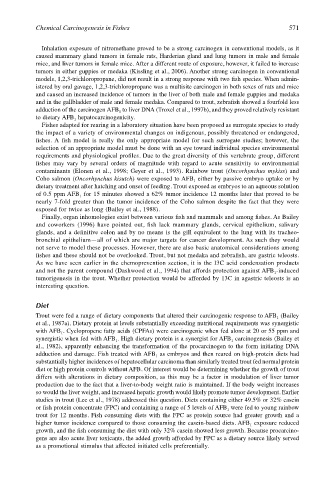Page 591 - The Toxicology of Fishes
P. 591
Chemical Carcinogenesis in Fishes 571
Inhalation exposure of nitromethane proved to be a strong carcinogen in conventional models, as it
caused mammary gland tumors in female rats, Harderian gland and lung tumors in male and female
mice, and liver tumors in female mice. After a different route of exposure, however, it failed to increase
tumors in either guppies or medaka (Kissling et al., 2006). Another strong carcinogen in conventional
models, 1,2,3-trichloropropane, did not result in a strong response with two fish species. When admin-
istered by oral gavage, 1,2,3-trichloropropane was a multisite carcinogen in both sexes of rats and mice
and caused an increased incidence of tumors in the liver of both male and female guppies and medaka
and in the gallbladder of male and female medaka. Compared to trout, zebrafish showed a fourfold less
adduction of the carcinogen AFB to liver DNA (Troxel et al., 1997b), and they proved relatively resistant
1
to dietary AFB hepatocarcinogenicity.
1
Fishes adapted for rearing in a laboratory situation have been proposed as surrogate species to study
the impact of a variety of environmental changes on indigenous, possibly threatened or endangered,
fishes. A fish model is really the only appropriate model for such surrogate studies; however, the
selection of an appropriate model must be done with an eye toward individual species environmental
requirements and physiological profiles. Due to the great diversity of this vertebrate group, different
fishes may vary by several orders of magnitude with regard to acute sensitivity to environmental
contaminants (Elonen et al., 1998; Geyer et al., 1993). Rainbow trout (Oncorhynchus mykiss) and
Coho salmon (Oncorhynchus kisutch) were exposed to AFB either by passive embryo uptake or by
1
dietary treatment after hatching and onset of feeding. Trout exposed as embryos to an aqueous solution
of 0.5 ppm AFB for 15 minutes showed a 62% tumor incidence 12 months later that proved to be
1
nearly 7-fold greater than the tumor incidence of the Coho salmon despite the fact that they were
exposed for twice as long (Bailey et al., 1988).
Finally, organ inhomologies exist between various fish and mammals and among fishes. As Bailey
and coworkers (1996) have pointed out, fish lack mammary glands, cervical epithelium, salivary
glands, and a definitive colon and by no means is the gill equivalent to the lung with its tracheo-
bronchial epithelium—all of which are major targets for cancer development. As such they would
not serve to model these processes. However, there are also basic anatomical considerations among
fishes and these should not be overlooked. Trout, but not medaka and zebrafish, are gastric teleosts.
As we have seen earlier in the chemoprevention section, it is the I3C acid condensation products
and not the parent compound (Dashwood et al., 1994) that affords protection against AFB -induced
1
tumorigenesis in the trout. Whether protection would be afforded by 13C in agastric teleosts is an
interesting question.
Diet
Trout were fed a range of dietary components that altered their carcinogenic response to AFB (Bailey
1
et al., 1987a). Dietary protein at levels substantially exceeding nutritional requirements was synergistic
with AFB . Cyclopropene fatty acids (CPFAs) were carcinogenic when fed alone at 20 or 55 ppm and
1
synergistic when fed with AFB . High dietary protein is a synergist for AFB carcinogenesis (Bailey et
1
1
al., 1982), apparently enhancing the transformation of the procarcinogen to the form initiating DNA
adduction and damage. Fish treated with AFB as embryos and then reared on high-protein diets had
1
substantially higher incidences of hepatocellular carcinoma than similarly treated trout fed normal protein
diet or high protein controls without AFB. Of interest would be determining whether the growth of trout
differs with alterations in dietary composition, as this may be a factor in modulation of liver tumor
production due to the fact that a liver-to-body weight ratio is maintained. If the body weight increases
so would the liver weight, and increased hepatic growth would likely promote tumor development. Earlier
studies in trout (Lee et al., 1978) addressed this question. Diets containing either 49.5% or 32% casein
or fish protein concentrate (FPC) and containing a range of 5 levels of AFB were fed to young rainbow
1
trout for 12 months. Fish consuming diets with the FPC as protein source had greater growth and a
higher tumor incidence compared to those consuming the casein-based diets. AFB exposure reduced
1
growth, and the fish consuming the diet with only 32% casein showed less growth. Because procarcino-
gens are also acute liver toxicants, the added growth afforded by FPC as a dietary source likely served
as a promotional stimulus that affected initiated cells preferentially.

